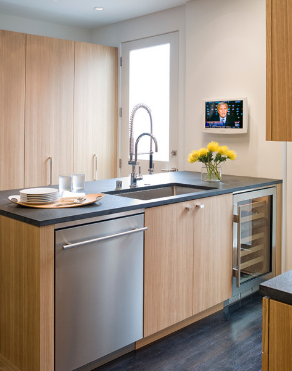When it comes to choosing a kitchen layout, most homeowners would most like to have an island. The island is great if you have enough space. They create extra work, storage space, and provide a place for family and friends to hang out without getting in the way of the chefs.
But sometimes the peninsula is the better solution. It has circulation on three sides, while the island has four, one end of which is usually attached to the wall. Of course, there are some Peninsula kitchens that you will find in a U-shaped kitchen, but there are others that will keep you coming back for more. After looking at these kitchens, you might want to put the peninsula at the top of your bucket list:

When you own a peninsula instead of an island, you can still mix countertop materials. Here, the top of the slaughterhouse doubles as a preparation area and a snack counter.

My personal favorite representation of the peninsula is the representation attached to a vertical wall without any cabinetry. It looks like an island; The only difference is that there is no aisle at one end, which often translates into more counter space and better circulation. This is a great solution for smaller kitchens. When you have to dig up at least 36 inches of space on either side of the island, this can really take up your real estate. If you’re looking for a more spacious circulation path, this is the place for you.
Tip: To get this look that looks more like an island on the peninsula, resist the desire to place cabinets on either side of a vertical wall or even above a counter.

Another layout of this kitchen could be L-shaped, with an island opposite the peninsula shown. To do this, you have to raise the window sill height and replace the window so that the base cabinet underneath can be installed. If you want to avoid doing such external work, a peninsula like this one is a great solution.

Since the peninsula style creates additional circulation space, you can often add another seat at the end of the counter.
Tip: For a more asymmetrical look, don’t make the peninsula the same length as the cabinet wall at the back. Hold back a little and give yourself a little more space to place an extra stool.

Here you can really see how much space is gained by connecting this peninsula to the wall. If this is an island with circulation on both sides, then that wine fridge will have to be removed, plus some. The top of the sink, which doesn’t have any counter space, is too small to provide a comfortable workspace.

In this L-shaped kitchen, the decision to build a peninsula on the island solved a lot of problems. There is more space in front of the stove, more counter space, and a better sense of separation between the kitchen and family room/lounge area (see below).

This is the same kitchen from the opposite point of view. The Peninsula helps define the kitchen as a separate space for the family room/lounge area.
Working on a similar premise, but in a larger kitchen, this peninsula helps define the room and increase counter space. It’s a perfect example of a kitchen, but a bit too narrow for a full-size island.

Even the smallest peninsula is worth the effort. Without this ingenious addition, this kitchen would not have any seats.

This L-shaped kitchen can accommodate a few stools and adds much-needed counter space.

Classic U-shaped peninsula kitchen. This allows the chef to be within his or her field and (technically) for others to be unaffected. The benches at the back of the peninsula form table seats instead of counter stool seats.


